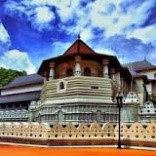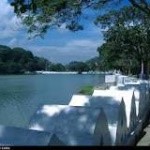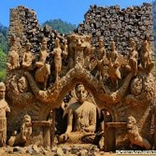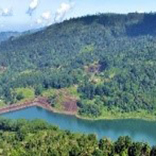Temple of the Tooth

Kandy, declared by UNESCO as a world heritage site was the capital of the Sinhalese Kings from 1592 to 1815. Sri Dalada Maligawa or The Temple of Tooth Relic is situated in the middle of the city. A sacred Tooth Relic of Lord Buddha is placed here for veneration. Sri Dalada Maligawa is considered the most venerated Buddhist shrine in the world. For this reason, it is annually worshipped many thousands of foreign visitors other than local Buddhists.
King Wimaladharmasuriya I (1592 - 1603) who was the first to establish a kingdom in Kandy originally built a two storied temple for the Relic and brought the tooth relic from Delgamuwa near Kuruwita in Sabaragamuwa which had been hidden for protection.
King Wimaladharmasuriya II (1686 - 1706) built a three storied temple and later his son King Viraparakrama Narendrasingha (1706 - 1738), the last Sinhalese king, built a new two storied temple.
The last king of Sri Lanka, Sri Wickrama Rajasinghe (1797 - 1814) built the Pattirippuwa (Octagon). Earlier, the Pattirippuwa was a part of the royal palace. It was used by the king to address his countrymen. Today the Pattirippuwa has become a part of the temple.
Kandy Lake

Lake in Kandy, Sri Lanka
Kandy Lake, also known as Kiri Muhuda or the Sea of Milk, is an artificial lake in the heart of the hill city of Kandy, Sri Lanka, built in 1807 by King Sri Wickrama Rajasinghe next to the Temple of the Tooth. Over the years, it was reduced in size.
Area: 19 haShore length: 3.4 km
Kothmale Rajamaha Viharaya

Pusulpitiya is a village in Kotmale about 3 miles from Morape on the banks of the Kotmale Oya. This area is full of folk legends as this is the area which Prince Dutugemunu spent his childhood when Elara was ruling Anuradhapura.
Kotmale Pusulpitiya Rajamaha Viharaya is historically linked with the Sacred Tooth Relic as it has found refuge here several times during the times of political unrest. It is said that the relic was hidden here during the Maga’s rule (1215-1236) at Polonaruwa. Vijayabahu III (1232-1236) took it back to Dambadeniya where he established the kingdom. The sacred Tooth Relic again found refuge here when the British entered the Kandyan Kingdom in 1815. But the British found it and took it back to the Kandy.
Kotmale Dam

The Kotmale Dam is a large hydroelectric and irrigation dam in Kotmale, Sri Lanka. The dam generates power from three 67 MW turbines, totalling the installed capacity to 201 MW, making it the second largest hydroelectric power station in Sri Lanka. Construction on the dam began in August 1979 and was ceremonially completed in February 1985. The dam forms the Kotmale Reservoir, which was renamed to Gamini Dissanayake Reservoir on 11 April 2003 following a request by Prime Minister Ranil Wickramasinghe.
Kotmale Reservoir

The Kotmale Reservoir which is nestled in the central highlands of the country between hills is indeed a breathtaking view. When watching its cool, clear waters ripple in the gentle breeze which blows across the vast expanse of water, no one would believe that there are many more things to feast one’s eyes on, beneath the tranquil waters. Submerged by the waters of the reservoir are the ruins of many temples and human settlements. In fact, more than 14 tea estates, 57 villages and about 54 ancient temples, among others are said to have gone under water when the reservoir was built. While many of these places do not exist at present, even underwater, some of them still do. Among these, the ruins of the Kadadora Vihara are spectacular, especially the sculptured statues of the Buddha and other deities. However, they are a rare sight and can only be viewed according to the whims of the weather gods.
